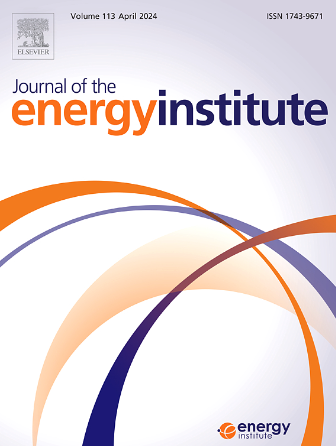Chemical mechanism development for ammonia/n-heptane blends in dual fuel engines
IF 5.6
2区 工程技术
Q2 ENERGY & FUELS
引用次数: 0
Abstract
Ammonia (NH3) is a carbon-free energy carrier with significant potential for sustainable transportation, particularly in heavy-duty applications such as trucks, construction machinery, agricultural equipment, locomotives, and ships. To enable the use of ammonia/diesel dual-fuel engines in these demanding applications, this study develops a reduced NH3/n-heptane chemical kinetic mechanism, with n-heptane serving as a single-component surrogate for diesel, designed for multi-dimensional computational fluid dynamics (CFD) simulations. The mechanism incorporates advanced sub-models for ammonia oxidation, n-heptane oxidation, and carbon-nitrogen interactions, improving predictions for both low- and high-temperature combustion phenomena. Validation against fundamental combustion data, including ignition delays and laminar flame speeds, confirms its accuracy and reliability. A key feature of this study is the further validation of the kinetic mechanism in CFD simulations using experimental engine data from ammonia port fuel injection and diesel direct injection compression ignition operation, effectively bridging fundamental research and practical applications. The simulations confirm the ability of the mechanism to predict primary engine combustion behaviors, including cylinder pressure, heat release rate, and key combustion characteristics such as ignition delay, premixed/diffusion combustion proportions, and nitrogen-based emissions trends (including unburned NH3, nitrogen oxides (NOx), and nitrous oxide (N2O)) across varying ammonia substitution levels. Additionally, the mechanism accurately captures the de-NOx effects of NH3, which modulate NOx and N2O concentrations during the late oxidation stage, with predicted emission levels closely matching experimental data. Overall, this work provides a robust and reliable tool to advance the development of high-efficiency, low-emission ammonia/diesel engine systems, thereby paving the way for cleaner and more sustainable solutions in heavy-duty transportation.
双燃料发动机中氨/正庚烷混合物的化学机理研究
氨(NH3)是一种无碳能源载体,在可持续运输方面具有巨大潜力,特别是在卡车、建筑机械、农业设备、机车和船舶等重型应用中。为了使氨/柴油双燃料发动机能够在这些苛刻的应用中使用,本研究开发了一种还原NH3/正庚烷的化学动力学机制,以正庚烷作为柴油的单组分替代品,设计用于多维计算流体动力学(CFD)模拟。该机制结合了氨氧化、正庚烷氧化和碳氮相互作用的先进子模型,改进了对低温和高温燃烧现象的预测。根据基本燃烧数据进行验证,包括点火延迟和层流火焰速度,证实了其准确性和可靠性。本研究的一个关键特点是利用氨口燃油喷射和柴油直喷压缩点火的实验发动机数据,在CFD模拟中进一步验证了动力学机理,有效地连接了基础研究和实际应用。模拟结果证实了该机制在不同氨取代水平下预测主发动机燃烧行为的能力,包括气缸压力、热释放率、点火延迟、预混/扩散燃烧比例以及氮基排放趋势(包括未燃烧的NH3、氮氧化物(NOx)和一氧化二氮(N2O))等关键燃烧特性。此外,该机制准确捕获了NH3在氧化后期调节NOx和N2O浓度的脱硝作用,预测的排放水平与实验数据密切匹配。总的来说,这项工作为推进高效、低排放氨/柴油发动机系统的开发提供了一个强大而可靠的工具,从而为重型运输中更清洁、更可持续的解决方案铺平了道路。
本文章由计算机程序翻译,如有差异,请以英文原文为准。
求助全文
约1分钟内获得全文
求助全文
来源期刊

Journal of The Energy Institute
工程技术-能源与燃料
CiteScore
10.60
自引率
5.30%
发文量
166
审稿时长
16 days
期刊介绍:
The Journal of the Energy Institute provides peer reviewed coverage of original high quality research on energy, engineering and technology.The coverage is broad and the main areas of interest include:
Combustion engineering and associated technologies; process heating; power generation; engines and propulsion; emissions and environmental pollution control; clean coal technologies; carbon abatement technologies
Emissions and environmental pollution control; safety and hazards;
Clean coal technologies; carbon abatement technologies, including carbon capture and storage, CCS;
Petroleum engineering and fuel quality, including storage and transport
Alternative energy sources; biomass utilisation and biomass conversion technologies; energy from waste, incineration and recycling
Energy conversion, energy recovery and energy efficiency; space heating, fuel cells, heat pumps and cooling systems
Energy storage
The journal''s coverage reflects changes in energy technology that result from the transition to more efficient energy production and end use together with reduced carbon emission.
 求助内容:
求助内容: 应助结果提醒方式:
应助结果提醒方式:


